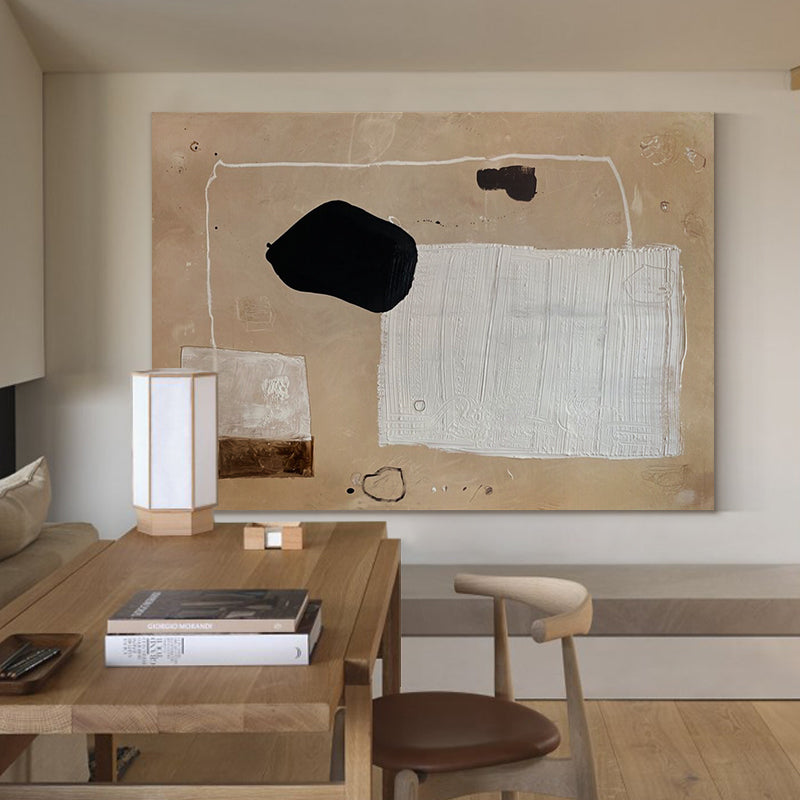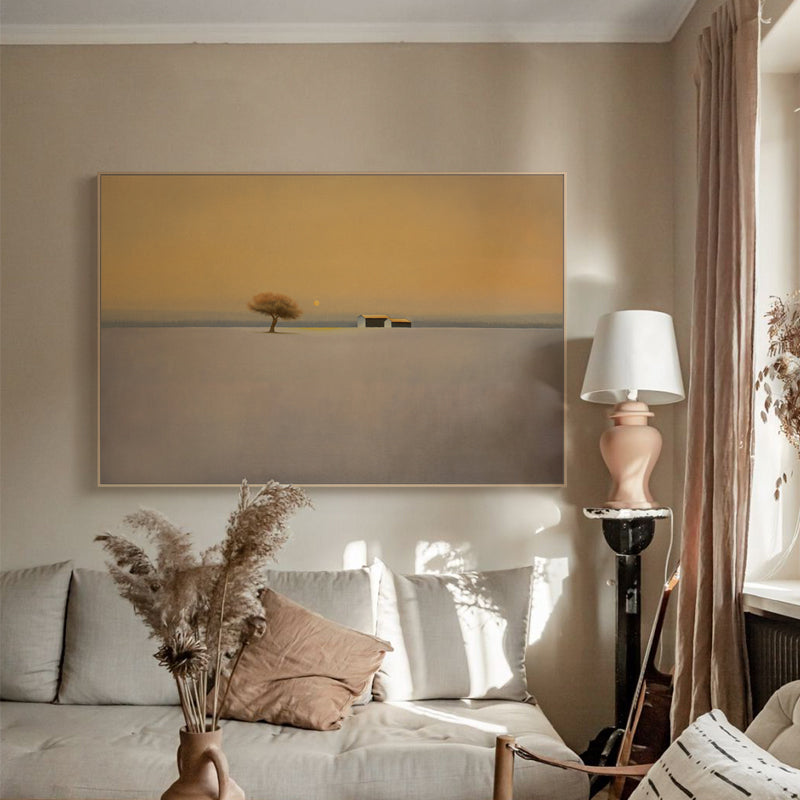Article: Define: Minimalist Painting

Define: Minimalist Painting
Minimalism, also known as Micromodularism, is not the modern Minimalism, but a school of art that emerged in the 1960s, which can also be called "Minimal Art", as a reaction to abstract expressionism and towards the extreme, with the most primitive object itself or form in front of the viewer as a way of expression. It intends to eliminate the oppressive nature of the author's work on the viewer's consciousness, minimize the violence of the work as a text or symbolic form, and open up the imaginative space of the work itself in terms of artistic concept, allowing the viewer to participate in the construction of the work on his or her own, and eventually become the author of the work under no specific restrictions.
What is Minimalism
Minimalism is a kind of non-realistic painting and sculpture that emerged in New York in the 1960s, with the idea of reducing the artist's own emotional expression in favor of simple, logical choices. Minimalism, also known as ABC Art, is the pinnacle of the simplification tendency in modern art. This reductionist tendency was first seen in 1913 in a work by the Russian painter Kazimir Ma-levich, which was composed of black squares on a white background. This art style is a combination of Russian Suprematism and Dutch Neoplasticism. Although its foundations are European, the large shapes, unlabeled subjects, and the notion that "artworks should be objective facts" are purely American. They envisioned three approaches to the problem of artistic composition: make it universal, make it minimal, and dematerialize it.
Minimalism primarily describes abstract, geometric painting and sculpture. Its main principles of artwork composition include: correct angles, geometry, cubes, proportions, scale, and the use of a minimum of incidental or compositional strategies of interpretation. Minimalism was a reaction to the spontaneous, anti-formal Abstract Expressionism of the 1950s, which was not satisfied with the action painting of the time. (Action painting was a form of American abstract expressionism, which was intuitive and spontaneous, and dominated the American avant-garde for much of the 1950s.) Minimalism, on the one hand, focused Pop artists on the images extracted from popular, consumer imagery, and on the other hand, Minimalism and Conceptual artists reoriented artistic inquiry by reducing objects to a phenomenological state (Minimalism) or to conceptual intent (Conceptual Art). The nature of the work is to remove the artist's own "real work" and instead use impersonal (often using industrial materials and techniques) workers directed by the artist to create the work. Its content is an attempt to erase all traces of graphics, incongruous combinations, or images of any living creature, and to capture the viewer's attention with large geometric shapes. The Minimalists believed that action painting was too individualistic and insubstantial, and therefore argued that a work of art should not involve anything other than itself; in this way, they attempted to remove any association with their work beyond its visual effect. They applied hard edges, simple forms and lines rather than painted strokes to emphasize a sense of second dimension and to promise the viewer a direct, purely visual perception of the work. The Minimalists turned to the cool, calm works of Barnett Newman and Ad Reinhardt, the typical Expressionist colorist painters, for inspiration.
Painting
The most important Minimalist paintings are the hard-edged, geometric and color-field works of Josef Albers, Ad Reinhardt and Barnett Newman. In addition, the hard-edged paintings of Ellsworth Kelly, Frank Stella, and Kenneth Noland are characterized by large, simple, often geometric shapes throughout the flat picture; precise, prominent contours; and large, bright, unblended colors on an unprimed canvas. Hard-edge painting differs from other types of geometric abstraction in that it rejects lyrical and mathematical compositions; for even in such a simplified context, the artist can still use them to express his personality. Minimalist hard-edge paintings are simply anonymous structures of a simple object. Minimalist paintings are known for their strongly colored grids, stripes, squares, square V's, inverted V's and circular patterns painted on large canvases. Their paintings often develop a series of works on a single subject, consisting of many standardized small units synthesized into a series of paintings. These works, using industrial paints or acrylic dyes, tend to be "unpainted" and often end up being mechanical and devoid of meaning. The critic Lawrence Alloway criticized the 1966 exhibition at the Guggenheim Museum in New York as "systematic painting. Other artists who produced Minimalist works include Robert Ryman, Patricia Ryman, and Al Held.
Sculpture
Minimalist sculpture aims to create an environment, whether outdoors or indoors. The sculptures are large, geometric, and often in a series; minimalist sculptures are extremely simple, large, geometric assemblages made of fiberglass, plastic, sheet metal, or aluminum. These materials are either left in their original rough state or thickly painted with bright industrial colors. Minimalist sculptors, like painters, strive to make works that are completely objective, non-representational, and non-referential. Tony smith has made steel boxes that he does not know whether they are finished or not. Robert Morris's rather rigorous but lively works include a 2.4-meter-tall triple-plywood dance arm, a huge gray and white plywood box, and other "monolithic" objects that relate to the physical space of each viewer. His Notes on Sculpture (1966-69) provides a penetrating and unique insight into minimalist art. Donald Judd believed that the non-minimalist sculptural tradition would be destroyed, and that simple forms that reinforced visual memory would replace the "specific object. Such simple objects, whether in metal, plastic, plywood, stone or other materials, are ubiquitous. Judd and Morris' work is mostly untitled. Other well-known minimalist artists include Sol Lewitt, who is famous for his white square frames; Carl Andre, who uses standard units (such as firebrick) to create ambient compositions; and Dan Flavin, who uses fluorescent lights to create ambient atmospheres.
Music
Minimalist music was clearly influenced by minimalist art such as the music of Erik Satie and the aesthetics of John Cage. Since some composers were opposed to the complex, intellectual and pretentious style of modern music, they began to compose music in a simple and realistic style and thus created a music that was extremely simple and accessible. Minimalist music is characterized by simple note elements and fixed rhythms to build a wall of sound that is repeatedly treacherous but simple and transcendent. The sound line changes all the time, but it is not detectable, so it often has a light but penetrating beauty. In both music and visual art, minimalism attempts to explore the basic elements of the art form. In minimalist visual art, individuality and gestural expression are excluded in order to highlight the objective, purely visual components of painting and sculpture. Minimalist music, on the other hand, excludes traditional approaches to musical form and phrase development in order to facilitate the exploration of a variety of timbral and rhythmic components, most of which are unfamiliar to Western audiences.


